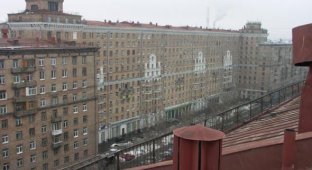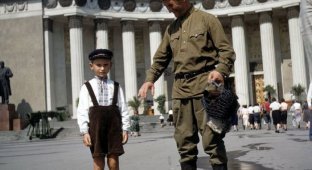Communal apartments are a phenomenon in our country that has not been eliminated to this day. Moreover, communal housing in its worst version - the barracks - remains today in some former industrial cities and urban-type settlements. And many of those who live in such communal apartments will never get out of them...
Communal services as a phenomenon.
We will not consider a situation where a group of students or girls of easy virtue rent an apartment together and live in it practically as in a communal apartment. This phenomenon took place both under the tsarist regime and under the Soviet system, and is currently observed under a system of some kind. Let us take for the subject of research only the communal apartment in its early Soviet understanding, when:
“Everyone lived on equal footing, modestly like this: a corridor system, for thirty-eight rooms there was only one restroom”...
And in the classic version, when already in the so-called Stalinist communal apartment, usually from 3 to 7 families lived.
Of course, practically one housing for 38 families (or a little less, since one owner could own two rooms) is cool. Such “multi-occupancy” communal apartments were located in apartment buildings and mansions of pre-revolutionary construction, slightly adjusted by reconstruction and the construction of additional partitions in the halls and living rooms to increase the number of rooms. At least, the communal apartment mentioned by Vysotsky, who lived as a child in Moscow on 1st Meshchanskaya Street, was probably located in one of these apartment buildings, with which almost the entire street was built up...

First retreat.
I remember this communal apartment very well. She was on the first floor of our Z-shaped house on Vosstaniya Street in the then Leninsky district. The house was, it seems, on the balance sheet of the Helicopter Plant, and mostly workers and employees of this largest enterprise in the city lived in the house.
Four families lived in this communal apartment. Our family lived nearby: in a one-room Stalinist house. Our apartment was large, with a huge hallway in which my father’s Izh motorcycle stood. There were four of us living in the apartment: my parents, my father’s mother and me. And in the communal apartment, where I went as if it were my home, since the door was locked only at night, there was a long corridor that ended with two doors: the toilet and the bathroom.
On the left side of the corridor there were three doors. Behind one lived my same year and classmate Vovka Gerasimov, behind the other lived Vovka Chernikov. Also my friend, a year older than me. The third door at the very end of the corridor led to a huge common kitchen.
There were two doors on the right side of the corridor. Behind one lived a lonely lady, not yet old, incredibly beautiful and dressed in silks. She was, it seems, one of the “former” ones. Or, rather, from the children of those who did not have time to go to Paris after the revolution.
The second door, at the end of the corridor, led to the apartment of Vovka Polyakov, also a year or two older than me. It seemed like he had a sister, but girls didn’t interest me at that time.
Thus, three Vovkas lived in the communal apartment at once. Me and them – that’s your backyard hockey team...

The beginning of Soviet communal apartments.
It all started with the decree of the All-Russian Central Executive Committee of August 1918, abolishing private ownership of real estate in cities. In empty and cleared of “White Guard elements” apartments, as well as in those inhabited by “bourgeois”, they began to move peasants and proletarians, several families at a time, according to hastily issued orders. The densification process has gone so far that the vast majority of multi-room apartments in tenement houses and mansions have become communal. One or two rooms were occupied with his family by a former official of some department, not known for counter-revolutionary acts, and the remaining five rooms were occupied by five families from villages, suburbs or urban workers' barracks. The kitchen and bathroom were, of course, shared.
Many of the lodgers saw a clean toilet and bathroom for the first time, and since it was not theirs, but someone else’s, the attitude was appropriate. In addition, rent was not charged in those days. Why take good care of something that costs nothing? And soon the apartments turned into filthy square meters, and the kitchen into a dirty and smelly breeding ground for cockroaches. What it was like for the previous owners to live with such settlers - it’s better to remain silent about that. Only famous doctors practicing at home, like Professor Preobrazhensky from “Heart of a Dog,” world-famous scientists, high-ranking officials and specialists who took the side of the Soviet regime and became “responsible workers” retained separate apartments. And so that “compactors” from the house committee did not come to them, for example, in the person of the chairman of the house committee, Comrade Shvonder, Comrade Vyazemskaya, disguised as a man, comrades Petrukhin and Zharovkin, they needed “the final piece of paper, actual, real ... armor!” ..

In a word, the process of transforming multi-room apartments into communal apartments, especially in large cities, whose population was growing due to refugees, front-line soldiers, and migrants from villages, has begun. And as a result:
— dirt in the common corridor;
- smelly toilets;
- clogged sewer;
— scratched bathrooms (if any);
— chipped ceramic tiles and chipped parquet;
— broken windows boarded up with plywood;
- broken granite (!) entrance stairs, etc.
“God, the house is gone. What will happen to steam heating!” Professor Preobrazhensky prophetically lamented...
Houses built in the 80-90s of the 19th century, the walls of which were not covered by destructive cast-iron “babas”, fell into such disrepair and disrepair that they began to be demolished in the 30s. And they literally demolished it before Khrushchev’s time. In 1955, the house with communal apartments on 1st Meshchanskaya, where Volodya Vysotsky’s parents and himself lived, was also demolished. Since the house was beyond repair...

The communal apartment as a mirror of the Soviet understanding of the world order.
The 30s and 40s did not bring any special changes to communal life. Except that the residents of communal apartments began to find a common language, somehow got used to each other and got used to the kitchen aromas of sour cabbage soup, rancid porridge and fish fried in machine oil. And we got used to pillowcases, panties, underpants, bras and leggings, hung in the same kitchen after washing. It was in communal apartments that a new type of person was forged, for whom any difficulties and inconveniences were nothing. He was simple-minded and often naive (both good things), and his whole life was on display, including his family relationships, his underwear, and the foods he ate.
The “Vorony settlements,” in one of which the writer Yevgeny Petrov lived and which he and Ilya Ilf described in the novel “The Golden Calf,” became fewer and fewer. But more and more communal apartments appeared, where people lived as a single family, intertwined with aspirations, interests and even destinies. They quarreled, of course, then they made up, they quarreled again... Then, sitting at the same table in the kitchen, in the corridor or in the largest room - and the table was arranged by sharing or together, whoever had what - they celebrated holidays, weddings, birthdays. They drank. Sang. They played the harmonica. They laughed and cried. In plain sight. And there was an amazing simplicity in this, probably strange if you look at it with today’s eyes, but so Russian and understandable. When you don't need more than what you have. And not because you don’t want to have something else. But because everything you need for life is there...

This is how it happened that the communal apartment, as a phenomenon of the post-revolutionary way of life, which was intended to be temporary, over the course of this very time turned into a common and understandable world order for many Soviet people. Which, in turn, determined the life of Soviet citizens for entire decades, becoming an integral part of the urban subculture.

Stalin's communal apartments.
It was a classic of communal living, which older Soviet people still remember. As already mentioned, Stalin’s communal apartments most often housed 3-7 families, depending on the availability of rooms.
There were several communal multi-room apartments in Stalinist buildings. They could be immediately recognized by the presence of several bell buttons at the front door, sometimes with surnames inscribed, sometimes with instructions on who to ring and how many times.

There were also several electricity meters depending on the number of apartments. There were several washbasins, but not according to the number of living families, but according to the number of water supplies. Family kerosene stoves were replaced by gas stoves, which again were not enough for all the families living in the apartment, and cooking on them took place one at a time. What was enough was kitchen tables: one for each family. Residents of communal apartments usually had lunch and dinner in their rooms. The table in the kitchen most often served as a cutting table for cooking, but could also serve as a dining table. Behind him, the adults had a quick breakfast in the morning and the children had a snack between games. Sometimes the men chose some table, no matter whose, to crush a bottle or two. The hostess of the table came, kindly shooed them away, and they moved to another seat. And we went to the toilet with our own seats, then only wooden ones, which could be conveniently hung on the shoulder, like a horse collar used to be.

There was a duty schedule that hung on the wall in a visible place, according to which each responsible tenant, that is, the renter of a room in the apartment, knew exactly when to clean the common areas: the kitchen, the corridor, the toilet. In apartments that had bathrooms, there was also a schedule for visiting them, for example:
- Kochetkovs - on Monday afternoon;
- Zakharovs - on Monday evening;
- Sveta - on Tuesday morning;
- Aaron Moiseevich - on Wednesday evening;
- Polina Markovna and Avdotya Markovna - on Thursday;
— Osipchuk – on Friday afternoon;
- Gennady Nikolaevich - on Friday evening and so on...

The kitchen in communal apartments was large even by today's standards. Here clothes were washed and hung out to dry, dishes were washed, preparations for the winter were made, in which neighbors willingly took part, and confidential women's conversations were held.
The kitchen, like the hallway, served as a playground for children. In it, despite the presence of tables, washbasins, gas stoves and other equipment, one could easily ride a three-wheeled bike, making circles and returning to the long corridor, which served as both a bicycle track and a treadmill. If it weren’t for the things that did not fit in the rooms and hung on the walls of the corridor or stood leaning against them - cabinets, chests, sleds, troughs, skis, strollers and bathtubs, boxes and cans - then it would have been possible to organize football battles in it.
In the evenings, the kitchen turned into a club where all the residents of the apartment gathered to spend their leisure time. Even ancient old men and women came, leaving their rooms only when needed. They stared at the children, trying to recognize whose they were, listened to conversations, trying to understand their essence, or sat quietly in the corner and read yesterday's newspapers left on the tables.
Speaking of children...

Children of communal apartments.
The children of communal apartments were, one might say, common. They were looked after together. They were raised together, often fed together and simply cared for as human beings. Any elder in a communal apartment was an unquestioning authority for these children. Children were also punished both individually and collectively if they committed a collective offense. Often their own children, as well as the Kochetkovs and Zakharovs, received belts from Gennady Nikolaevich for hooliganism, and this did not make the Kochetkovs and Zakharovs mortal enemies of Gennady Nikolaevich. If, of course, the children received a fair scolding. That is, let's get down to business.
Children of communal apartments easily entered rooms other than their own, which were rarely locked (except in case of planned sex), treated themselves at other people's dining tables, and - amazingly - rarely disturbed anyone. And if they were somehow expelled from the kitchens, then the corridor was entirely at their disposal. It is difficult to imagine that in this state of affairs these children could grow up to be rednecks or beeches, shunning people and loving only themselves. The children of communal apartments grew up lively, cheerful, unpretentious, savvy and always ready to come to the rescue of a friend. It was a pleasure to be friends with them...

Second retreat.
I came to these three Vovkas as if to my own home. I was mine. And he immediately joined their corridor games. We made noise mercilessly. And when they hit a child’s bathtub with a ball and it still fell from the wall onto the floor, there was such a roar as if someone was hitting a sheet of galvanized iron with a crowbar overhead. I don’t know about the others, but we were delighted by such sounds and laughed until we dropped.
Of course, corridor battles only happened in bad weather. And so we spent whole days in the yard, occasionally running home to grab a piece of bread, spread with jam or sprinkled with granulated sugar, and immediately rush back. We always had no time. And I don’t remember that these three Vovoks ever quarreled among themselves, not sharing something...

The residents of the communal apartments lived in harmony. There wasn't much to share. And everyone understood that if there was no peace in such a large group, almost a family, then the not-so-sweet life could turn into such a nightmare that God forbid. Therefore, anyone without an invitation could enter any room where he did not become “worse than a Tatar.”
By the way, Russians, Belarusians, Tatars, Chuvash, Mari, Mordovians and other nationalities of the USSR got along well in communal apartments. And there were absolutely no conflicts on ethnic grounds. It’s just that the Belarusian Vasil turned into Vasya, the Tatar Ildus into Ilya, and the Chuvash Yakhvar into Yasha. And everyone was equal.

And how they walked in communal apartments at a common table on big holidays! The song is simple! All the children also sat at a common table, only at their own, a children’s table, which was built in the same kitchen separately from the adult’s table. After eating, they ran into the yard to play, leaving the adults with their salads, dumplings, vodka and songs about the daring Khasbulat, the lonely accordion and the darling in a protective tunic. Of course, it was interesting to listen to the conversations of adults. But it was even more interesting to complete the headquarters in the yard, play football with the boys from the neighboring house and feed Zhulka’s fold-eared puppies.
Common problems, common interests, common entertainment, common destiny... It probably wasn’t very good after all. Judging from the point of view of an individual. But why then, having moved into a two-room apartment that my father received from the Helicopter Plant, for another three years, every weekend and on holidays, I came to that Z-shaped house of ours on Vosstaniya Street, came to the three Vovkas, and it seemed to me that nothing as if nothing has changed?
However, today I know the answer to this question very well...
























